Written by Georgia Valentonis, 2025
My grandfather, Joseph Valentonis was born on September 19, 1900, in Geguzine, Lithuania. His parents were Joseph and Barbara (Zikaraite) Valentonis. He had two brothers, Stacys and Vincas, and two sisters, Grasilda and Veronica. Joseph was the fourth child born to his parents. The elder Joseph was a peasant farmer and sent the children out to be shepherds, which the younger Joseph did until he was 15 years old. The First World War broke out, and the farmer that Joseph worked for left Lithuania, taking the cows and everything he owned to Russia. Joseph went with him, and spent time in many different places in Russia over the new few years. He was drafted into the Russian army and spent 6 years with them. He saw some fighting action in the war, and a bomb landed close to him and damaged his ear (causing a broken eardrum) and sustained some damage to his eye. Lithuanians lived under the rule of the Russian Empire until February 16, 1918, when Lithuania was re-established as a democratic state.
Upon return to Lithuania, at the border, the Lithuanian guards took all of Joseph’s clothes and possessions, and put him in jail because he had spent time in Communist Russia. One of his brothers got him out of jail (we are unsure how long he spent there), and he was able to return home. He then spent about five years working in Lithuania, marrying his wife Ona in early 1926.
My grandmother, Ona (Miseviciute) Valentonis was born in Talackoniai, Lithuania, on May 24, 1898, and her parents’ names were Jurgis Misevicious and Agota Tamuleviciute. We believe she had four siblings, and know that her sister, Bessie Lukpetris (married name) left Lithuania before Ona and moved to Chicago. Ona had two sisters named Konstancija and Barbora (we are unsure which one was nicknamed Bessie), and her two brothers were Juozas and Jonas. The three siblings besides Ona and Bessie all stayed in Lithuania.
Once Ona and Joseph were married in early 1926, they lived with Joseph’s parents for a while in Geguzine, Lithuania. Their son Jurgis (George in English) was born on November 25, 1926, in his grandparents’ house. Ona and Joseph named their son after Ona’s father, a customary practice in Lithuania. Joseph applied to emigrate to Canada shortly after this. He left for Canada on his own, on the ship ‘Regina’, arriving on April 10, 1927 into the port of Halifax. First, he went to Winnipeg to look for work, then he went on to Wowota, Saskatchewan, where he knew people whom he hoped may sponsor Ona and the baby Jurgis to also come to Canada. Joseph had to work for a full year to pay off their passage. Ona and Jurgis set sail on the ship ‘Minnedosa’ and arrived at the port of Saint John, NB, on December 24, 1927.
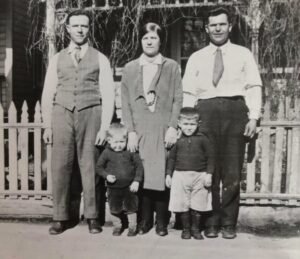
L-R Unknown, Charlie, Ona, George and Joseph Valentonis in Winnipeg, c. 1930 (photo courtesy of Georgia Valentonis)
Then, they boarded a train to Saskatchewan. The family stayed for a bit more than a year, and then came to Winnipeg because Ona wanted to be closer to the Catholic Church. Joseph did odd jobs, but we think they ended up on relief (welfare) for a couple of years. The language barrier was particularly a problem for them. They lived in the Point Douglas area of Winnipeg (Euclid, Sutherland, and Annabella Streets). A second son, Charlie, was born to them on November 3, 1928.
The family applied for a ‘Back to the Land’ farm grant for a ¼ section of land in Lee River, outside of Lac du Bonnet, in 1933 (section 33-15-12w). This came with a $600 cash credit to buy supplies, so they bought a team of horses and a harness, two cows, a plow, a wagon, and other farming equipment. Joseph went in July of 1934 and put up a partial cabin. The rest of the family came in November of 1934, and lived with the Clement Pudjunas family for a month and a half. They cleared land, milked cows, built a bigger house, and eventually began to set up farming, slowly acquiring more livestock. Both George and Charlie walked approximately two miles to the Lee River School, with George finishing grade 5 and Charlie grade 8. The family only spoke Lithuanian at home and to their Lithuanian neighbours, such as the Zalys family. George and Charlie would go on to learn English in school, but Joseph and Ona were hesitant to learn English. With some Latvians already settled in the Lac du Bonnet area, and the Lithuanian and Latvian languages being quite similar, people speaking either language could understand each other to a degree.
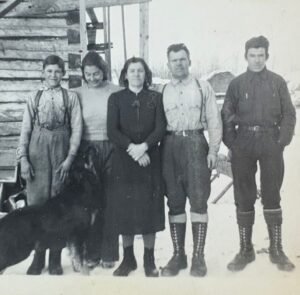
L-R Charlie Valentonis, Lilly Zeemel, Ona, Joseph, and George Valentonis, c. 1942 (photo courtesy of Diane Neal)
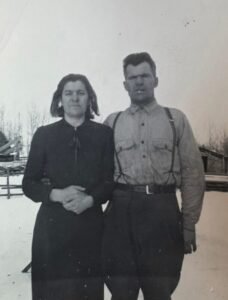
Ona and Joseph Valentonis, c. 1942 (photo courtesy of Georgia Valentonis)
In the early farm years, the family reached Winnipeg by taking a horse and carriage to Lac du Bonnet, and then Red River Bus Lines on to the city. The government kept close tabs on the family with inspectors, so Joseph lined up Charlie’s godfather, Tony Stragus, to buy the farm from the government and keep it for over a year until Tony had to have surgery. He then transferred the land back to Joseph. The family lived on the farm the whole time, and sold some of it off to produce the money to refund Tony (this was done somehow to get out of the eye of the government).
When the boys were young, the family ate mostly bush rabbits, porcupine, and partridge that they shot themselves. Meat was kept in jars in the well, or in a hole dug in the ground. Ona had a vegetable garden, and she made borscht, homemade noodles, sauerkraut, her own bread, and later, salt pork. They made butter and eggs to sell, and later cream too, in 1952-53.
The family’s first car was a 1936 Nash Ambassador 6, bought with money from selling off some equipment and cattle. In 1943, Joseph started to work in the bush seasonally for Water’s Construction, while farming the rest of the year. The two boys worked on the farm, cutting wood until Christmas, then Joseph and George would take a team of horses to swamp wood (hauling piles of cord wood out of the bush to the truck road). They did this until 1945, and then quit Water’s Construction. Joseph stayed on the farm, and George, Charlie, Oscar, and Eric Nilsson went to work for Mike Switz, cutting pulp in Great Falls for one winter. In 1945-46, George worked for Alex McIntosh swamping wood. In 1947, George bought 240 acres of Crown Land that he worked himself. He bought a 2-ton Mercury truck in 1948 and hauled wood to Pine Falls mill, until 1950.

Ona Valentonis, c. 1945 (photo courtesy of Diane Neal)
In 1940, Ona had a tumour discovered in her womb, though it was successfully removed. She recovered but constantly worried that it would return, with this stress and worry leading to the onset of hypochondria. This continued until 1949, when George took her to see Dr. Bill Reid in Selkirk, and he decided to have her receive shock treatments in the Selkirk Mental Institution. She was better for a while and managed at home. Gradually, she exhibited worsening symptoms and began behaving strangely. Then, on July 9th, 1950, after being told that she should return to the Mental Institution, she disappeared the next day. After a week’s exhaustive search by family, neighbours and authorities, the search was called off, and she was never found.
George was twenty-three at the time, and Charlie twenty-one. Charlie had been away working in a mine in BC when his mother disappeared, but had gotten back quickly to join in the search for her. He decided to stay home again, and George bought a truck so they could haul wood together. They did haul wood to the mill for a couple of winters, until October of 1952, when Charlie married June Woods and then worked on his own. George stayed on the farm and continued to haul wood in winters until 1956-57. He had worked on the farm from age 13 to 29.
***
I often think about how hard the life of an immigrant must have been. I think about my grandmother Ona specifically – the twenty-three years spent in Canada must have been hard and quite lonely for her. At that time, having any form of mental illness would have been exceedingly difficult. Between the unorthodox treatments and probable frequent misdiagnoses, it must have been torturous for a lot of people. And like many immigrants, you had left your home and your family behind and never were able to see them again. There were a lot of sacrifices made by these immigrants to (hopefully) give their children and grandchildren a better life.
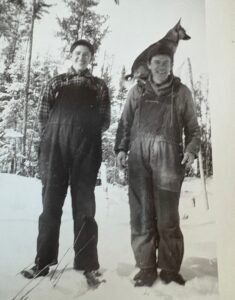
Charlie and George Valentonis, c. 1945 (photo courtesy of Georgia Valentonis)
My father George worked really hard throughout his life as well, without much education, to try to get ahead . A lot of the work of the immigrant was hard, physical labour, combined with long hours and not many comforts.
My grandfather Joseph stayed on the farm until approximately 1966, when he married Annie Kekish and moved into the town of Lac du Bonnet. Charlie bought the farm.
George had left in the spring of 1957 to do construction work for Water’s Construction. He first met Chiquita (Chickie) Texmo in 1951, and they began dating in 1955 after meeting again. Eventually, they moved into their long-time house, 82 Fifth Street, (Lac du Bonnet) in 1963. That winter, George went to work for the Abitibi Pulp and Paper Company, doing cat skinning (driving a Caterpillar tractor in the bush). George and Chickie’s only child, daughter Georgia, was born in March of 1967.
In his later years, Joseph returned to Lithuania twice to visit his remaining family there. He was in his seventies at this point and had not been back there since he left at age 26. At the time of the two visits in the 1970s, Lithuania was under the iron rod of the USSR, so travel in and out was very tightly controlled. He would have had to submit an exact itinerary of where he would be going while there, who he would be staying with, and he was not allowed to deviate from any of it. The second time he went, he did deviate
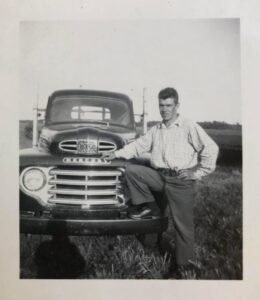
George Valentonis, c. 1952 (photo courtesy of Georgia Valentonis)
from his itinerary as he was trying to get a birth or baptism certificate for George, as they had come to Canada without it. George suspected that he might have issues getting his Canadian pension without it, even though he had been a landed immigrant in Canada since he was an infant. When Joseph was looking for the birth certificate, he was arrested by the police and detained. They did let him go, but only if he promised never to return to Lithuania. This really shook him up and he never did go back.
Joseph passed away on December 27, 1977, on the way to Pinawa Hospital after suffering a sudden and massive heart attack. Although my grandfather died when I was 10 years old, I still remember him very fondly. He had been a very gentle and calm presence in my life until he passed away. He liked to laugh and joke around, still speaking his broken English. He enjoyed his retirement years, which I am glad for, as his early life was certainly fraught with many challenges and a lot of uncertainty and hard work.
George continued to work various positions at Abitibi for almost 30 years, later acting as production and then assistant supervisor.
Charlie and June retired and sold the farm in Lee River after their children had grown up. They moved to Pinawa for a brief time and then back into the town of Lac du Bonnet, where they enjoyed the rest of their retirement.
Charlie passed away from cancer on November 21, 2004, and George from a stroke and later cancer, on September 24, 2007.
Through their sons George and Charlie, Joseph and Ona had five grandchildren.
Charlie and June had four children: Teena, Keith, Barbara, and Lee.
George had only one child, Georgia.
To take it further, there are now eleven great-grandchildren, six great-great-grandchildren and two great-great-great-grandchildren, with a third on the way!
Many of the descendants of Joseph and Ona still live in Lac du Bonnet, Winnipeg, and other areas of Manitoba.
There is a road called ‘Valentonis Road’ in Lee River, which leads to the Valentonis (right side) and Nilsson (left side) former farms and homesteads. This road is opposite to the Black Bear subdivision and golf course off Highway 433 (Lee River Road), approximately ten minutes outside of Lac du Bonnet, Manitoba.
***
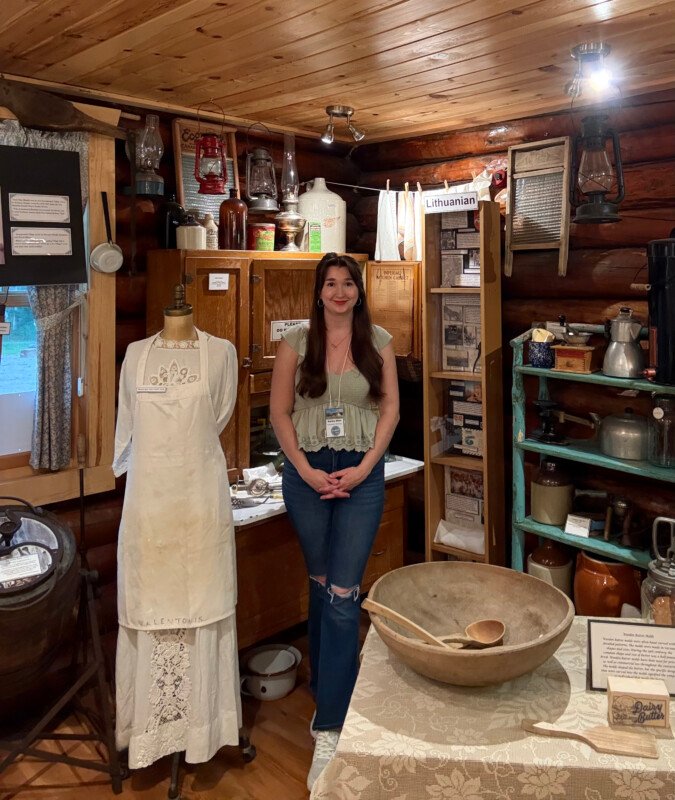
Marina Milne in front of Lithuanian display, beside Valentonis apron, 2025 (photo courtesy of Marina Milne)
Lac du Bonnet District Museum’s newest exhibit on the Lac du Bonnet area’s Lithuanian immigrants was put together by Marina Milne (Georgia Valentonis’ daughter) while she was the Museum’s Assistant Director during the spring and summer of 2025.